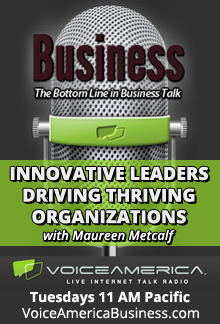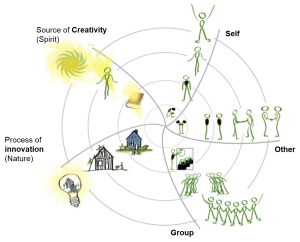Todayâs Innovative Leaders Driving Thriving Organizations topic is Ecosynomics and the science of abundance, a quantitative framework developed by Jim Ritchie-Dunham and team based on extensive data collected across 93 countries identifying the factors that make an organization vibrant. This post highlights a key element of the Ecosynomics framework and how it drives organizational abundance by improving an organizationâs ability to innovate out of key problems and create strategic advantage. You can learn more on the radio show, where he appears with Christoph Hinske, a fellow at the Institute for Strategic Clarity, and James Drinkwater, a senior policy advisor at the World Green Building Council.
How often have you worked in a situation where you withheld recommendations because it was easier to keep them to yourself than risk implementing something difficult? Does your organization unconsciously support the status quo rather than continually update what it does and how it performs work? The unconscious âagreementsâ we make with one another and with the company often drive behaviors that sub-optimize performance.
Here is an example of why Ecosynomics matters. When working for a technology company, Bill proposed several IT cost saving ideas. He was part of HR at this company, but had a strong technical background, which made the recommendations solid. Though they would have cut the licensing cost of HR software by $1 million per year, his suggestions were not implemented because the organization lacked a mechanism to make the suggested changes â it was less risky for all involved to continue with a higher-cost vendor than take on the personal risk of making a change that could be difficult to implement.
Enter Ecosynomics: a highly validated framework, set of assessment tools and transformation process that helps organizations address this type of endemic challenge.
The Institute for Strategic Clarity developed Ecosynomics based on observations of thousands of âpositive economic deviantsâ (AKA, the ârock starsâ of their categories) in 93 countries and 12 languages. The framework names the phenomena and supports all forms of social systems in making the shift from being stuck in the scarcity-driven structures proposed by contemporary economics to abundance-based structures offered by scientific insights. This well-tested framework quantifies the cost of scarcity and benefits of abundance, providing both a starting point and guiding frame for organizations to shift in ways that seemed impossible before now.
Ecosynomics looks at what people around the globe are doing to move from perceived realities of scarcity â characterized by ingratitude, âstuckness,â anxiety, apathy, mistrust, antisocial competitiveness, active disengagement and a high level of organizational failure â to perceived realities of abundance characterized by enthusiasm, flow, creative capacities, effectiveness, efficiency, trust, social solidarity and wellbeing. The research shows this is a basic, universal experience every human being knows: worldwide, tens of thousands of groups and teams in business, government, civil society, networks and communities are in the process of experimenting with and reinventing their fundamental agreements. They are discovering that they can generate higher levels of economic growth and business health, and lead the way to more productivity and job creation.
A key foundation of Ecosynomics is that (often unconscious) agreements among members of a group are the differentiator between organizations that consistently transcend the constraints of daily organizational lives and those that donât. By creating conscious agreements that enable participants to identify creative solutions, they can more intentionally determine how to implement innovation and execute for results. Organizations that canât do this will be outpaced by those that can.
The problem with most organizational agreements is that we donât see them. They just are. Most often, we are unaware that what is happening around us is based on an agreement that one could potentially change. It seems that life is just that way. In our day-to-day interactions â at work and at home â we engage in a set of agreements and relationships whether we realize it or not. Sometimes they work, resulting in vibrant experiences and great outcomes, and sometimes they do not, leaving us feeling depleted, fatigued and disappointed about lousy outcomes. These agreements are a key foundation of organizational culture; as the agreements change, they drive culture change.
Ecosynomics makes it possible to see the often hidden, underlying agreements that most affect the human experience, enabling people to choose which fundamental assumptions they accept, the structures and processes that result from those assumptions, and the behaviors they want to experience in their daily interactions with others. It provides a unified framework for describing what tens of thousands of groups identified by ISC are learning.
Jim and his team discovered that these groups start from a different initial assumption than economic scarcity. They start with abundance. Ecosynomics, the social science of abundance, explains what they are learning and how it changes all the rules of the game.
Vibrant groups also achieve higher levels of social integration and governmental/administrative efficiency and effectiveness. They are demonstrating new ways of relating that are more sustainable and lead to higher performance and innovation than the currently accepted norm. What people in those groups are doing cannot be achieved by applying present-day economic agreements of scarcity (defined as state of lack, or not having enough, restricted in quantity).
The emerging science of Ecosynomics provides a model to begin to name the field that observers and practitioners are discovering associated with creating vibrant organizations. Vibrancy (the move away from scarcity) is required to drive the foundational changes needed to navigate the challenges we face as a society today. Unless we take an abundance mindset (a view that we can solve the problems we face using innovative thinking), we are destined to leave our children a world that is worse than the one we inherited.
The Ecosynomics framework is a model of health that describes what people are learning about how to move from lower to higher vibrancy and economic prosperity. Vibrancy is what social systems experience when they are identified with and acting out of their greatest potential. It implies the concordance of diverse perspectives in a shared, meaningful whole, resulting in the emergence of a new, larger possibility.
To act out of our greatest potential, we found five key relationships that must be in alignment. When I am with a group/organization:
â¢Self: I feel good about who I am and what I am learning (I can share my aspirations and contribute my greatest potential, and trust that others support my success â including allowing me to make mistakes and learn).
â¢Other: I believe others in the group support my success, and I support them (we donât actively undermine one another).
â¢Group: I support and contribute to the organizationâs mission and culture. The organizationâs leadership acts ethically and works for the good of its people and clients.
â¢Source of Creativity/Spirit: We create an environment where creative ideas are solicited from everyone. We actively seek ways to continually improve our organization.
â¢Process of Innovation/Nature: We pilot creative solutions and continually improve what we do and how we do it to meet the needs of all stakeholders.
If any of these relationships are out of balance, we will perform in a sub-optimal manner.
To learn about your organizationâs vibrancy, take the free Ecosynomics vibrancy assessment. To learn more about the Institute for Strategic Clarity and the frameworks, follow this link or subscribe to Jimâs blog.






